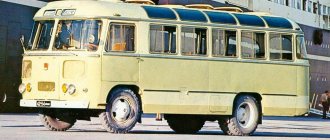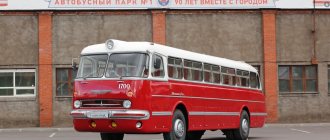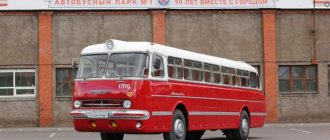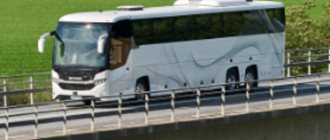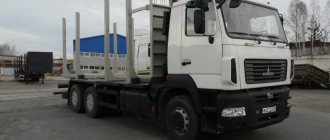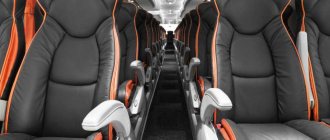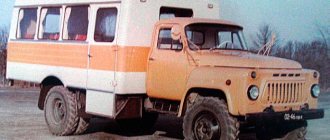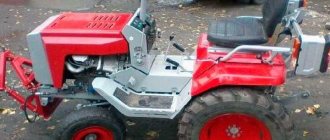City bus Volvo 7900 Electric. Volvo Photos
Not only comfort and ease of maintenance , but also the safety of life of passengers and driver depend on the choice of bus brand. The article examines one of the flagships of transport production - Volvo, which for many years was in the shadows, but by the standards of bus production and immediately won the love and respect of people.
How are Volvos classified?
The main criterion for classifying a company's buses is the purpose and nature of the route . Volvo has 4 classes: city, suburban, tourist and intercity.
Bus Volvo B10M. Photo Wikipedia
Based on this, the models differ in their characteristics and configuration. For example, a city bus is equipped to be more environmentally friendly, while on an intercity bus the passenger comfort becomes the decisive factor.
Volvo buses - past and reality
Volvo not only produces cars and trucks, but also produces buses. Its division, Volvo Bussar AB, produces bus chassis and is one of the world's largest manufacturers. It also produces complete buses of its own brand, parts and components for them.
Models
Urban
B10M
A model built on the chassis of the same name, which has found enormous popularity in the world - B10M, with a capacity of 50 passengers. It was supplied to dozens of countries from the United States to Japan. The latter tried to master the production of buses on this chassis, part of a batch of which ended up in Australia.
| Engine: | 9600 cc, L6, 12 valve. |
| Dashboard: | Mechanical. |
| Checkpoint: | 5-speed automatic transmission. |
| Brake system: | Pneumatic, drum. |
| Suspension: | Front - independent on a subframe, spring struts; The rear is semi-independent on trailing arms. |
It was the 50-seat modification that gained success, eclipsing other versions of the model, the reason for this was the successfully selected ratio of the number of axles, power unit and chassis - this model wore out noticeably longer in comparison with others.
7900
The bus is produced in three modifications - diesel, electric and hybrid. The most popular is the biaxial model with two sections; the cabin contains comfortable seats, up to 42 pieces. No less popular is the model with three axes and two sections. The capacity of the two-section bus is 154 passengers.
| Engine: | D5, 2400 cc, turbo; |
| Dashboard: | Digital. |
| Checkpoint: | 2-speed automatic transmission. |
| Brake system: | Pneumatic, disc. |
| Suspension: | Pneumatic, electronic control with tilt function. |
It compares favorably with other models with its aluminum frame and upper part, which means a reduction in the weight of the structure, and, accordingly, a reduction in fuel consumption by up to 40%, which has a positive effect on the environment.
Tourist
Carrus 9700
highly comfortable bus with a 4x2 and 6x2 wheel arrangement, designed for passenger transportation on intercity and regional routes. Capacity ranges from 37 to 49 seats. The salon is equipped with a TV system, coffee machine and microwave oven. There are 3 versions - hybrid, plug-in hybrid and electric.
| Engine: | Volvo DH12E Euro-4, 12000 cc. |
| Dashboard: | Digital. |
| Checkpoint: | 12-speed automatic transmission Volvo AT2412C. |
| Brake system: | Pneumatic, electronic control, disc. |
| Suspension: | Spring / pneumatic, electronic control, front - independent |
There is a wide visibility a high level of noise insulation , both external sounds and technical aspects of the bus mechanics, is also noteworthy The 9700 is exactly the kind of machine where individual parameters put it on the list of the best models.
9900
Luxury tourist bus serving on international passenger transport routes on public roads. Up to 49 seats have been arranged . In this model, the frame is made entirely of stainless pipe, the side walls are made of the same material and are mounted on the frame by welding, which has a positive effect on corrosion resistance.
| Engine: | DH12D340, 12000 cc; D11K 10400 cc |
| Dashboard: | Digital. |
| Checkpoint: | 3-speed, automatic transmission. |
| Brake system: | Pneumatic, electronic control, disc. |
| Suspension: | The front is a double-wishbone independent, the rear is a multi-link on a transverse composite spring; optionally - pneumatic. |
standard equipment in the 9900 : ABS, ESP, air conditioning with individual climate zones, audio system, 19-inch monitor, collision warning function, etc.
9500
This model is the result of installing the 9700 case on the more economical B9R chassis, but with an adjustment: the stainless panels are replaced with aluminum. an underrun guard was added to the design of the front part , due to which the vehicle exceeded the safety requirement of the R29 cargo standard by one and a half times, which makes it practically the safest bus in the world. The total number of seats has been increased to 53 passengers.
| Engine: | Diesel D9B380 Euro-5, 9000 cc. |
| Dashboard: | Digital |
| Checkpoint: | 3-speed automatic transmission. |
| Brake system: | Hydraulic with pneumatic retarder, disc. |
| Suspension: | Pneumatic, dependent. |
The increase in comfort, safety and efficiency was the perfect completion of the 9700 model in the form of the 9500.
Suburban
8900
A family of commuter buses with a two- and three-axle layout was born in 2010 , and then entered production. They flaunt a modern design and powerful diesel engines , and are offered in two versions - city and intercity.
| Engine: | D8K, 7700 cc, turbo. |
| Dashboard: | Digital. |
| Checkpoint: | 3-speed automatic transmission. |
| Brake system: | Hydraulic, electronic control. |
| Suspension: | Pneumatic. |
It differs from the urban version in the average height of the ceiling - in the freed-up space there is a compartment for passengers' luggage.
A slightly open window to Sweden
The bus has standard warranty conditions for a market newcomer - 1 year without mileage limitation. The warranty period for drive components is twice as long - 2 years - and also without mileage restrictions. Service intervals for Russia are up to 60,000 km. Unless changing the gearbox oil is now only every 400,000 km.
Daily exercise was initially designed for European standards: sat down, turned the key - the self-diagnosis system said “OK” - let’s go.
Those who don’t believe in electronics will still only spend a couple of minutes checking the bus. The front lifting mask simply opens a “window to Sweden”, allowing you to easily replace any bulb or headlight from the front optics, check the terminals on the signals, get to the defoster or remove the spare tire. In the stern, too, everything is as it should be - the air filter and coolant reservoir are located on the left, and the oil dipstick, engine neck, fuel filter, and external engine start remote control are located on the right. Let me emphasize that they are arranged, and not scattered throughout the engine compartment. Pleasant little things - two backlights at once, covered with bright red plugs, holes for towing loops and well-made necks on all containers - the water extravaganza is cancelled. Technical characteristics of the VOLVO 9500 bus
| Overall dimensions, mm | 12 290x2550x3610 |
| Total weight, kg | 18 000 |
| Curb weight, kg | 13 400 |
Passenger capacity, persons,
| 49 49 |
| Luggage compartment capacity, m3 | 10 |
| Permissible load on 1st/2nd axles, kg | 7100/ 11 500 |
Engine:
| VOLVO D9B380 Turbodiesel, I-6, Euro 5 9365 380 at 1900 min-1 1740 at 1200 min-1 |
Transmission:
| VOLVO AT2412C Robotic, I-Shift 12/4 |
| Suspension | Front and rear dependent with shock absorbers and stabilizers |
| Brake system | Pneumatic dual-circuit with disc brakes |
| Wheel formula | 4x2 |
| Minimum turning radius, m | 9,8 |
| Fuel tank capacity, l | 480 |
| AdBlue tank capacity, l | 60 |
There were no words of criticism for other technological compartments. Except that the batteries are poorly located - along the side, and the second battery is hidden in a niche. Getting it will be problematic. The rest is a solid “A”.
In general, having familiarized yourself with the new product, it seems that the Swedes deliberately, for some hidden reasons, do not want to enter to the sounds of timpani. They even voiced the price tag of 270,000 euros with guilty intonations, they say, “we understand - it’s expensive, but something like this...”. Guys, be brave! Your fellow competitors voice exactly the same figures with pride: “Have you seen how expensive buses we sell!” So VOLVO definitely has a chance for decent competition in the Russian market. It’s just that I’m increasingly concerned about the question: if they offer a bus with SUCH a set of consumer qualities of the highest level with caution, then what will the car be like that they will loudly announce - A SPACEMAN?
What does it mean for system models: Electric and Hybrid?
Hybrid - A system that charges batteries from an internal combustion engine. The ability to travel a decent distance on electric power is practically negligible in today's realities. Unlike the Hybrid, the Plug-in hybrid battery is not charged from external sources, which is why the environmental friendliness of this type is expressed only in reduced fuel consumption , thanks to the transmission of torque to the electric motor. Nowadays, this type of engine is considered obsolete and costly to maintain. To put it exaggeratedly, the hybrid is equipped with an electric motor designed to help the internal combustion engine, recharging from its own energy.
Volvo 9500 intercity bus running on diesel fuel. Volvo Photos
Plug-in Hybrid is an intermediate stage in this branch. The first difference from its predecessor is that it is equipped with more capacious batteries , as a result of which it becomes possible to cover a greater distance using electric traction. Secondly, they have the ability to charge from an external network , which makes the electric motor more autonomous. Depending on the model, a bus equipped with such a system is capable of traveling on electric power from 10 to 25 kilometers at a limited speed, above which the internal combustion engine is switched on.
Electric is a full-fledged electric bus. Absolute autonomy due to the absence of an internal combustion engine determines its main difference from its predecessors. The electric vehicle is easy to maintain; such a system does not contain many components inherent in internal combustion engines. For this reason, the system is several times cheaper than conventional internal combustion engine cars - there are no costs for lubricants, repairs or replacement.
How to choose the right model?
The first thing to consider when choosing is the type of route on which the bus will be used. For a city route , a Plug-in Hybrid or a fully electrified car (Electric) is suitable, since urban transportation takes place over a relatively short distance and when the battery energy is used up, there is always the opportunity to get to a battery charging station in the bus depot or change the type of power to continue the journey.
On suburban and intercity routes, it would be more logical to choose a car with an internal combustion engine. Unfortunately, alternative power systems are not able to provide high mileage without recharging, so the usual diesel engine will remain in service for a long time and there will be no special difficulties with its maintenance.
Intercity bus Volvo 9700. Photo Volvo
Having focused on the internal combustion engine, we should not forget that Volvo still produces the usual Hybrid package, designed to reduce fuel consumption and the load on the standard engine. This option is more economical.
In addition to the food system, there is a bus class. Additional luggage compartments, multi-zone air conditioning, a microwave and a coffee maker will be superfluous in a minibus, but in a regular bus they are necessary attributes.
For different road conditions, a specific type of suspension and tires , which affects the service life of the components and traffic safety.
Another factor of choice is the number of seats . A large number of seats is suitable for long-distance routes; in the city, with frequently changing passenger traffic and the distance between stops is no more than 5 minutes, standing places are more appropriate.
The final aspect is the climatic conditions of the route . Despite the company's almost complete transition to corrosion-resistant materials, the production of budget models made of ferrous metals has not been canceled. The choice of a body made of stainless steel and aluminum is more relevant for the central and northern regions. For the south, the material of manufacture is not so critical - thanks to the constant above-zero temperatures and low air humidity, rust is a rare occurrence here.
Of all the variety of choices, perhaps only Volvo takes the safety of its products so seriously, while not forgetting to ensure proper comfort. It is the legendary quality and approach of the manufacturer that makes it worth choosing this brand.
What is due to Jupiter?
Today, Volvo Trucks is positioning the year-old model as a special version created for the Scandinavian countries, where the vehicle height has recently been increased to 4.40 m. Perhaps this was a government order, since sales of the Volvo double decker were limited only to Sweden. Ulf Magnusson, Senior Vice President of the European Business Unit of Volvo Buses, confirmed: “We have already received several orders for the double-decker bus from the Scandinavian market, and we are very pleased that we can now also offer this express bus and tourist bus to other European customers. premium class bus. It is possible that such buses were also purchased by Finland, where these vehicles are assembled at the plant of Carrus Delta Oy, which is part of Volvo.
It is unlikely that the project was conceived only for Scandinavia - it is too expensive. So why didn’t Europe accept the car? It's very simple: the height of the Scandinavian Volvo 9700 DD double-decker bus is 4.25 meters. Let us remind you that in the EU, as in Russia, the permissible height of a vehicle is 4 meters. But what about the London Routemaster, you ask, is it 4.38 meters tall? How can one answer this, it seems that the ancient Greeks were right when they once said: “What is allowed to Jupiter is not allowed to the bull.”
Just a year ago, some astute journalists wondered: how to operate such a bus in Europe? After all, the legislation, which specifies a maximum height of 4 meters, cannot be exceeded. Apparently, this is what happened - the bus had to duck.
